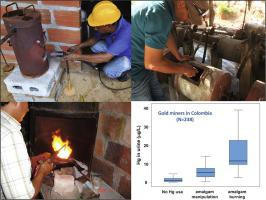Environment International ( IF 11.8 ) Pub Date : 2020-11-09 , DOI: 10.1016/j.envint.2020.106216 Clelia Calao-Ramos , Andrea G. Bravo , Roberth Paternina-Uribe , José Marrugo-Negrete , Sergi Díez

|
With the aim of protecting human life and the environment, the Minamata Convention seeks to reduce and monitor mercury (Hg) concentrations in the environment. Artisanal and Small-scale Gold Mining (ASGM) has been identified as the most important anthropogenic source of Hg at a global scale and an important route of human exposure to Hg. In this context, this study assessed total Hg (THg) in blood, urine and hair, and methylmercury (MeHg) in human hair samples from 238 participants with occupational exposure to Hg in the most relevant ASGM communities of Colombia. Mercury concentrations in different biological matrices were related to several variables of interest such as age, gender, body mass index, fish consumption, exposure time, and specific occupational activities, such as amalgamation and amalgam burning. The median values of THg in blood (3.70 µg/L), urine (4.00 µg/L) and hair (1.37 mg/kg), and hair MeHg (1.47 mg/kg) for all participants were below permissible concentrations set by WHO. However, about 40% of the miners showed Hg concentrations in blood, urine and/or hair above the WHO thresholds. In all the biological matrices studied, miners burning amalgams showed significantly higher concentrations than miners who did not burn amalgams, with values 7-, 7-, and 8-fold higher in blood, urine and hair, respectively. A multiple linear regression model revealed that burning amalgam and fish consumption were significant predictors of Hg exposure in miners. Miners from Guainía had the highest concentrations in urine and hair, most likely due to the high manipulation and burning of amalgam, and a high fish consumption. In contrast, miners from Caldas showed the lowest Hg concentrations in all the biomarkers because they do not manipulate or burn amalgam, as well as reporting the lowest fish consumption. Our study also highlighted that gold miners exposure to Hg depends on their work practices. Therefore, the implementation of a health education programme on gold mining strategies is required, especially in Guaina, Vaupés, Córdoba, and Antioquia departments.
中文翻译:

哥伦比亚手工小型金矿开采社区的人为汞接触职业
为了保护人类生命和环境,《水am公约》力求减少和监测环境中的汞(Hg)浓度。手工和小规模金矿开采(ASGM)已被确定为全球范围内最重要的人为汞源,也是人类接触汞的重要途径。在这种情况下,这项研究评估了来自哥伦比亚最相关的ASGM社区中238名职业性接触汞的参与者的血液,尿液和头发中的总Hg(THg)和人发样品中的甲基汞(MeHg)。不同生物基质中的汞浓度与几个相关变量有关,例如年龄,性别,体重指数,鱼类消耗,接触时间以及特定的职业活动,例如汞齐化和汞齐燃烧。血液中THg的中位数(3。所有参与者的尿液(70 µg / L),尿液(4.00 µg / L)和头发(1.37 mg / kg)和头发MeHg(1.47 mg / kg)均低于WHO设定的允许浓度。但是,约40%的矿工的血液,尿液和/或头发中的汞浓度高于WHO阈值。在所有研究的生物基质中,燃烧汞合金的矿工的浓度明显高于未燃烧汞合金的矿工,其血液,尿液和头发的值分别高7、7和8倍。多元线性回归模型显示,燃烧汞合金和鱼类消费是矿工汞暴露的重要预测指标。来自瓜伊尼亚的矿工尿液和头发中的浓度最高,最可能的原因是汞合金的高度操纵和燃烧以及鱼类的大量消费。相反,来自Caldas的矿工在所有生物标记物中均显示出最低的Hg浓度,因为它们不操纵或燃烧汞合金,并且报告的鱼类食用量最低。我们的研究还强调,金矿工人接触汞的程度取决于他们的工作习惯。因此,需要实施有关金矿开采策略的健康教育计划,尤其是在瓜伊纳,瓦佩斯,科尔多瓦和安蒂奥基亚省。


























 京公网安备 11010802027423号
京公网安备 11010802027423号